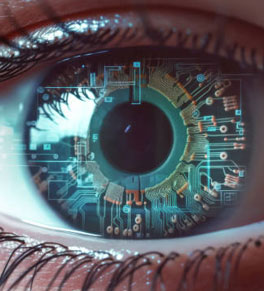Harnessing AI to revolutionize eye care for patients

“AI is going to enhance doctors’ ability to rapidly detect problems and changes in our patients’ eyes,” says UCI Health retina specialist Dr. Andrew Browne.
Artificial intelligence tool are taking the world by storm, not least by the physician-scientists at the UCI Health Gavin Herbert Eye Institute, who are creating AI-powered innovations to advance vision care.
Dr. Ken Y. Lin and Dr. Andrew Browne already are using AI to improve patient care. They are also hard at work developing new ways to model a patient’s eye’s anatomy, to render infrared images in full color, and even help sight-challenged patients identify their prescription bottles.
“People tend to think AI is a post-pandemic novelty, but in reality it has already transformed various aspects of medical diagnostics,” says Lin, a specialist in glaucoma and cataract surgery who also holds a doctorate in biophysics.
“Aspects of AI have been quietly running in the background to ensure greater accuracy and efficiency in care delivery.”
For example, Lin notes that no two patients who take vision field tests experience the exact same series of flashing lights in their periphery. Thanks to AI, their diagnostic machine is able to adapt the eye exam based on each person’s first few responses.
Helping patients see
An eye surgeon who works primarily with patients affected by glaucoma and cataracts, Lin has used his deep-machine learning studies to develop devices for treating glaucoma. He’s always looking for ways AI tools can help his patients. Recently, he noticed that many patients were having trouble identifying their eye drops, which come in small bottles with even smaller print.
“The irony is that people who need eye drops the most are the ones who have the biggest problem identifying their medications in the first place,” he says.
That inspired Lin to develop an AI-powered smartphone app using a smart phone camera to recognize and tell patients which eye medicine they are holding. The UCEye Bottle Identifier app, available for download at Google Play, is now being used by eye institute patients. He is working on a newer version that would also give instructions on how and when to use each of type of prescription drops.
Easier 3D imaging
Both physicians are also using AI to develop better diagnostic tools.
Browne, a retina specialist who has a PhD in electrical and computer engineering, is working on creating 3D models of patients’ eyes using basic ultrasound equipment. Today, modeling the eye’s anatomy requires MRI or CT scans, equipment not typically found in an ophthalmologist’s office. These scans also can be time consuming and expensive for patients.
Browne’s device, now under patent review, takes images of the eye’s anatomy then uses AI-augmented tools to build 3D models. This will allow doctors to better monitor patients with retinal problems and other conditions, such as thyroid eye disease, optic neuritis, intracranial hypertension and pathological myopia.
Assisting eye surgeons
Browne and Lin are also leveraging AI technology to improve surgical outcomes.
Browne has helped develop an AI-powered process to recreate full-color images from photos taken under infrared light, which is invisible to the human eye. This technology could help surgeons operating in low-light conditions.
Lin has developed an AI tool to visualize the eye’s trabecular meshwork — a spongy tissue targeted in most minimally invasive glaucoma surgeries. The meshwork is difficult to discern even under a high-powered surgical microscope.
“It’s similar to assisted driving,” explains Lin. “The AI tells you where the trabecular meshwork is, but the surgeon still has to make the decisions.”
Browne is also collaborating with computer scientists to develop AI-augmented surgery models that could improve patient outcomes. By combining videos of eye surgeries with data on the results of each procedure, AI can find patterns and nuances that lead to the best surgical outcomes, something that can be difficult for individual surgeons to discern in an unbiased way.
“If we want to learn the definitive impact of more subtle actions that surgeons take during an operation, then we need objective tools to analyze the data from thousands and thousands of surgeries,” he explains.
Both Lin and Browne expect AI to play an increasingly important and beneficial role in ophthalmology.
“AI is going to enhance doctors’ ability to rapidly detect problems and changes in our patients’ eyes,” Browne says.
“We will examine what the technology highlights for us, confirm whether we agree with it and that will allow us to make decisions much more quickly and efficiently. Ultimately, that’s going to be very important for physicians trying to give patients the best possible care.”
Related stories
- Alert eye specialist saves artist's sight ›
- His passion: Helping kids see ›
- Eyes: A window to brain ›
- A sister's gift restores sight ›





